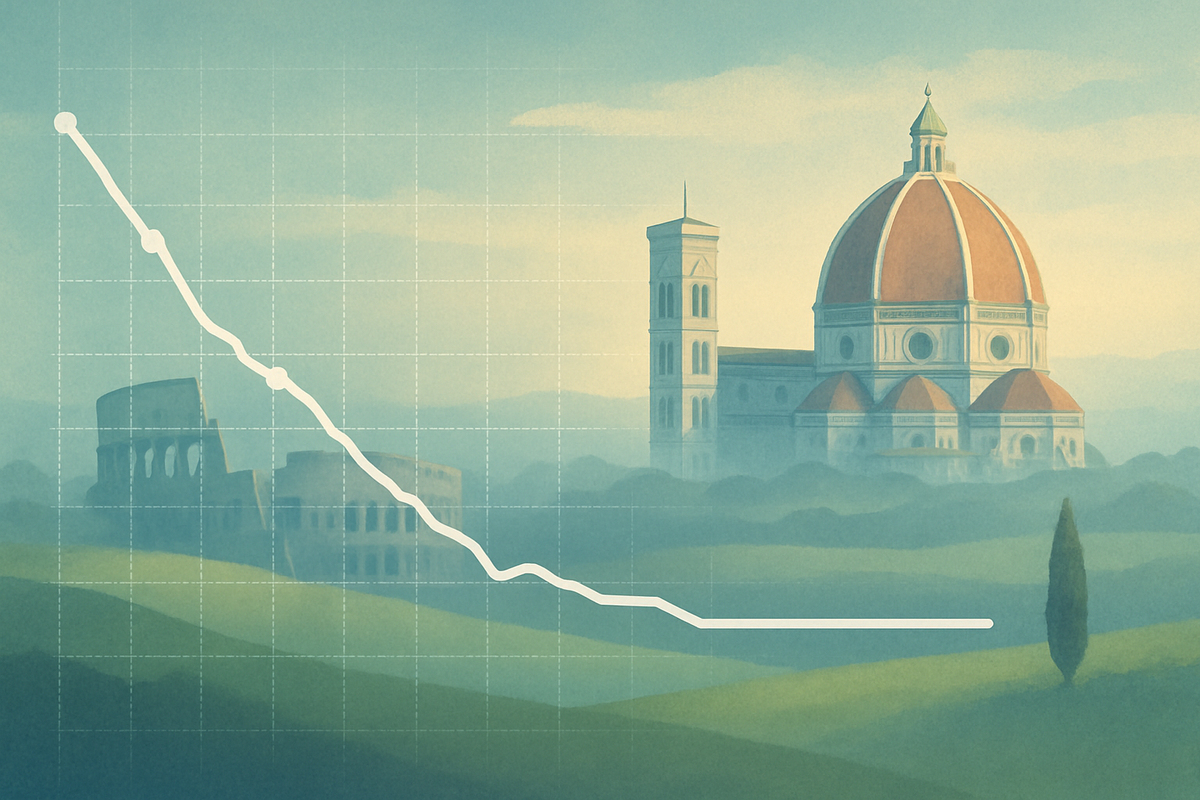
ROME – October 16, 2025 – Italy's battle against inflation appears to be entering a new phase of stability, as the latest data reveals a consistent annual consumer price index (CPI) in September 2025, following a notable dip in August. The Italian National Institute of Statistics (Istat) reported that the annual inflation rate held steady at 1.6% in September, confirming preliminary estimates and signaling a potential reprieve from the persistent price hikes that have challenged households and businesses across the nation. This stabilization, while largely anticipated by financial markets, carries significant implications for Italy's economic trajectory and the broader Eurozone, potentially influencing future monetary policy decisions by the European Central Bank.
The consistent inflation figures suggest that the aggressive monetary tightening by central banks may be yielding its intended results, gradually taming inflationary pressures without severely stifling economic growth. For the average Italian consumer, this could translate into more predictable purchasing power and a slight easing of the cost-of-living squeeze. However, the underlying dynamics of this stability – a mix of declining transport and food costs offset by rising energy prices – warrant closer scrutiny to understand the true resilience of Italy's economic recovery.
Detailed Analysis of Italy's Inflationary Landscape
The path to Italy's current inflation rate of 1.6% in September 2025 has been characterized by a gradual deceleration. After peaking earlier in the year, the annual consumer price inflation (NIC) eased to 1.6% in August 2025, down from 1.7% in July. This marked the lowest reading since May and provided the first strong indication that inflationary pressures were indeed cooling. The subsequent stability at 1.6% in September, coupled with a 0.2% monthly decline in consumer prices, further solidified this trend. The Harmonised Index of Consumer Prices (HICP), a key metric for comparison across the Eurozone, also registered an annual increase of 1.8% in September.
Key factors contributing to this trend include a notable easing of prices for transport-related services, which saw a slower increase of 2.4% in September compared to 3.5% in August. Unprocessed food prices also contributed to the deceleration, rising by 4.8% in September, down from 5.6% in the previous month. Conversely, the cost of regulated energy products saw a faster increase, climbing by 13.9% compared to 12.9% in August, while the deflation in unregulated energy products moderated to -5.2% from -6.3%. This intricate interplay of rising and falling costs highlights the complex nature of current economic forces at play.
The Italian National Institute of Statistics (Istat) is the primary agency responsible for collecting and disseminating these crucial economic indicators, providing the foundation for policy decisions. The European Central Bank (ECB) also stands as a central stakeholder, closely monitoring inflation data from member states like Italy to guide its overarching monetary policy for the Eurozone. Initial market reactions to the September data were largely subdued, as the 1.6% figure aligned closely with analyst expectations. This suggests that the market had already priced in the stabilization, leading to no dramatic shifts in major indices. However, sectors particularly sensitive to inflation, such as consumer goods and utilities, may experience nuanced, sentiment-driven movements as investors recalibrate their assessments of pricing power and operational costs.
Corporate Winners and Losers in a Stabilized Inflation Environment
The stabilization of Italy's inflation rate presents a mixed bag for public companies, creating both opportunities and challenges across various sectors. Companies with strong pricing power and efficient supply chains are better positioned to thrive, while those heavily reliant on imported raw materials or operating with thin margins may continue to face headwinds.
Potential Winners:
- Retail and Consumer Staples: With inflation holding steady, consumer purchasing power is less eroded, potentially boosting demand for non-discretionary goods. Companies like Esselunga (BIT: ESSE) and Coop Italia, major players in the Italian supermarket sector, could see stable sales volumes. Their ability to manage input costs effectively will be crucial.
- Utilities (Regulated): While regulated energy prices saw an increase, the overall stabilization of inflation might allow regulated utilities, such as Enel S.p.A. (BIT: ENEL), to maintain predictable revenue streams and potentially pass on some cost increases within regulatory frameworks without facing significant consumer backlash due to broader economic instability.
- Manufacturing Exporters: A more stable domestic economic environment, particularly if it signals broader Eurozone stability, can indirectly benefit Italian manufacturing companies like Ferrari N.V. (NYSE: RACE) or Leonardo S.p.A. (BIT: LDO). A predictable cost base at home, combined with potentially stronger demand from international markets benefiting from a stable Euro, could improve their competitive edge.
- Bond Market & Financial Institutions: Lower and stable inflation typically leads to more predictable interest rate environments. This can be beneficial for banks like Intesa Sanpaolo S.p.A. (BIT: ISP) and UniCredit S.p.A. (BIT: UCG), as it reduces uncertainty around lending rates and improves the stability of their bond portfolios.
Potential Losers/Challengers:
- Discretionary Consumer Goods: While overall consumer confidence might improve, companies selling high-ticket discretionary items, like certain luxury fashion brands or automotive manufacturers beyond the ultra-luxury segment, might still face cautious spending if household budgets remain tight from past inflationary spikes.
- Companies with High Debt: Although interest rate hikes might slow down with stable inflation, companies carrying significant variable-rate debt could still face higher financing costs compared to pre-inflationary periods, impacting profitability.
- Unregulated Energy Companies: While regulated energy prices rose, the moderation of deflation in unregulated energy suggests a less dramatic price drop than before. Companies in this segment might face continued volatility and pressure on margins if global energy prices remain unpredictable.
- Small and Medium-sized Enterprises (SMEs): Often with less bargaining power over suppliers and less access to sophisticated hedging strategies, SMEs may continue to struggle with absorbing residual cost pressures, even in a more stable inflationary environment. Their ability to pass on costs without losing market share will be critical.
The key for all companies will be their agility in adapting to the "new normal" of inflation, focusing on operational efficiencies, strategic pricing, and robust supply chain management.
Wider Significance and Macroeconomic Implications
Italy's inflation stabilization is not an isolated event; it fits into a broader narrative of the Eurozone's ongoing struggle to bring price pressures under control. The European Central Bank (ECB) has been aggressively hiking interest rates over the past year to combat stubbornly high inflation across the bloc. Italy's latest figures provide a hopeful sign that these measures are working, aligning with the ECB's target of 2% inflation in the medium term. This trend could potentially influence future ECB decisions, possibly signaling a pause or a slower pace of rate hikes, which would have ripple effects across all Eurozone economies.
A stable inflation rate in Italy can bolster consumer and business confidence, encouraging investment and spending, which are crucial for economic growth. However, the composition of the inflation—where certain essential goods like regulated energy are still rising—means that households may not feel the full relief immediately. This could lead to continued pressure on real wages and a cautious approach to discretionary spending.
Historically, periods of high and volatile inflation have often led to social unrest and economic instability. The current stabilization, therefore, is a welcome development, preventing a potential repeat of more severe economic downturns seen in past decades. Comparing this to the early 2000s, when Italy experienced relatively low and stable inflation, the current environment, while improved, still reflects a higher base level. The challenge now is to ensure this stability is sustainable and does not merely represent a temporary lull before another inflationary surge, especially given ongoing geopolitical uncertainties and supply chain vulnerabilities.
Regulatory bodies will be closely watching. The Italian government, for instance, might consider targeted fiscal measures to support vulnerable households still impacted by specific rising costs, such as energy. Simultaneously, the European Commission will be assessing Italy's economic performance within the Stability and Growth Pact, where inflation control is a key component. Any sustained divergence from Eurozone averages could trigger further scrutiny or recommendations.
Navigating the Future: Short-Term and Long-Term Outlook
Looking ahead, the short-term outlook for Italy's inflation suggests continued stability, with potential for minor fluctuations driven by seasonal factors or specific commodity price movements. The key question remains whether this stability can evolve into a sustained disinflationary trend, bringing the rate closer to the ECB's 2% target. Analysts will be closely watching upcoming data on energy prices, wage growth, and core inflation metrics, which exclude volatile items, for further clues.
In the long term, Italy faces the challenge of fostering sustainable economic growth while maintaining price stability. This will require strategic pivots from both the government and private sector. Companies might need to invest more in automation and digitalization to improve productivity and reduce reliance on potentially volatile labor costs. Supply chain resilience will remain a critical focus, with businesses seeking to diversify sourcing and localize production where feasible to mitigate future shocks.
Market opportunities may emerge in sectors that benefit from increased consumer confidence and stable operating environments, such as tourism, services, and technology. Conversely, challenges will persist for industries heavily exposed to global energy price volatility or those struggling with structural inefficiencies. Potential scenarios range from a "soft landing" where inflation gradually returns to target without a significant recession, to a more challenging "stagflationary" environment if growth falters while inflation remains elevated. Investors should prepare for both, prioritizing diversified portfolios and companies with strong balance sheets and proven adaptability.
Conclusion: A Cautious Optimism for Italy's Economic Path
Italy's inflation rate holding steady at 1.6% in September, following a decrease in August, marks a significant milestone in the country's economic journey. It signals a period of cautious optimism, suggesting that the peak of inflationary pressures may be behind us and that the stringent monetary policies of the ECB are beginning to take hold. The immediate implications are a more predictable economic environment, which, while not a complete return to pre-inflationary normalcy, offers a welcome respite for businesses and consumers alike.
Moving forward, the market will be keenly assessing whether this stabilization is durable. Investors should watch for further data on core inflation, wage developments, and consumer spending patterns. The ECB's next moves on interest rates will be paramount, as any adjustments will significantly impact borrowing costs and investment decisions across the Eurozone. While the immediate crisis of runaway inflation seems to be abating, the underlying structural challenges of the Italian economy, such as public debt and productivity growth, remain.
The lasting impact of this period of inflation and its subsequent stabilization will likely redefine corporate strategies, emphasizing resilience, efficiency, and adaptability. For investors, the coming months will be crucial for identifying companies that can navigate this evolving landscape, distinguishing between those that merely survive and those that are positioned to thrive in a moderately inflationary, yet more stable, economic climate.
This content is intended for informational purposes only and is not financial advice






